In recent years, and especially in 2020, eCommerce has grown busier and noisier. Today’s consumers spend more time on screen and have more reasons to shop online. However, they also face a barrage of social media posts, email campaigns, app notifications, and more, making their online experience more distracting than ever. While you can’t control the entirety of your customers’ online journeys, the one channel you have complete control over is, of course, your website. Once shoppers find themselves on your site, you need to get their attention and guide them through the right buying journey towards purchase. To do so effectively, you need a powerful, customer-focused eCommerce merchandising strategy.

What is eCommerce Merchandising?
eCommerce merchandising shares the same principles as traditional merchandising done in physical stores. Its goal is to increase sales via the strategic placement and order of products, collections, and promotions.
Beyond displaying the right items at the right time, smart online merchandising also ensures that shoppers discover the products they’re looking for with ease, associating your brand with an overall great experience.
A Quick Overview of Online Merchandising
When planning your eCommerce merchandising strategy, it’s a good idea to consider five key areas: Product tagging, product assortment, design features, merchandising rules, and shopping methods.
- Product tagging is the process of detecting and assigning tags or attributes that accurately represent and describe products.
- Product assortment deals with the variety of products that you have in stock and sell online. It also refers to how they appeal to your site visitors.
- Design features include your branding, the look and feel of your website, as well as the various on-site elements that drive conversion and sales.
- Merchandising rules refer to how you group, rank, and present products to inspire purchase, including techniques for cross-selling and upselling.
- Shopping methods are the means your customers employ to find products they want — or how they navigate through your site.
For brands and retailers with a large inventory, it is crucial to make the most of these eCommerce merchandising opportunities updated by making adjustments and improvements daily. This ensures that your customers’ paths to purchase are always relevant, engaging, and seamless, no matter where or how they enter your website.
The Importance of Product Tagging as the Foundation for eCommerce Merchandising
Product tagging is the infrastructure on which all merchandising is built. On the frontend, it determines which products your customers discover when they’re using on-site search or just navigating through your menu. Detailed tags also enable you to deliver shopping experiences according to users’ individual aesthetic preferences.
On the backend, you use product tags to keep track of the thousands of SKUs you have in your inventory. When you create and adjust merchandising rules, you can group products using tags. For example, you may select SKUs with a specific color or of a certain style or price via their tags, and then create a collection for a promotion or display them as featured items on your homepage. Effective tagging allows you to carry out these merchandising efforts easily, at scale.
In addition to improving discoverability, detailed product tagging also enables you to more effectively monitor and understand sales data and demand, so you can optimize your inventory. Comprehensive product tags provide deeper insight into your customers’ shopping behaviors—down to the minute product details that they prefer.
With so much riding on your product tags, relying on tagging teams to input the data is risky — it can result in missed details as well as inaccurate and inconsistent tags. It is also a time-consuming and resource-intensive process. To improve online merchandising and customer experience overall, many leading brands today rely on AI-powered tagging solutions that use computer vision to automatically identify and add tags to their products.

How to Optimize eCommerce Merchandising Throughout the Customer Journey
With so many options, today’s shoppers need to be engaged and discover products that speak to them not just at their initial touchpoint with your site, but throughout their journey — otherwise, they’ll simply drop off to a competitor.
To separate your brand from the competition and create a more compelling journey that promotes product discovery throughout, you need to consider how your eCommerce merchandising strategy plays out and how your customers behave in the following arenas:
- Search and navigation: Most site search users are high-intent shoppers because they already have an idea of what they’re looking for. eConsultancy found that shoppers who use search convert at 4.63% versus the average conversion rate of 2.77%. On the other hand, shoppers who navigate independently may simply be browsing or they may already know what they have in mind but are not sure how to put it into words.
- Homepage: It is rare for new shoppers to land on your website’s homepage from an external search engine. Usually, it’s your loyal customers that get there directly. Still, for all kinds of shoppers, the homepage is the place on your website where they expect to see a comprehensive preview of your brand and catalogue. Your homepage must be enticing to compel shoppers to explore more.
- Category and product detail pages: Shoppers on these sections of your website are either close to making a purchase decision, or deep in the exploratory stage. In both cases, it’s crucial to use tactics that build trust and persuade them to add products to their cart.
- Shopping cart and checkout: These are the final stages of the buyer journey, yet many shoppers end up abandoning the process at this point. As of 2019, the average cart abandonment rate was 69.57%. To prevent this, you need to keep users engaged even this deep in the funnel and provide them with compelling reasons to continue to checkout while removing all potential friction.
Now, let’s take a look at how you can optimize eCommerce merchandising and create exceptional product discovery experiences at each of these stages in the journey:
1. eCommerce Merchandising in Search and Navigation
In physical retail, the store layout provides strategic positioning of products to optimize shoppers’ various paths to product discovery and purchase. Online, you do that with smart merchandising and site architecture. Search and navigation are the visible tools that provide structure and guide shoppers to the products they’re looking for.
Search
As mentioned, search users are usually high-intent shoppers because they already know which product they want. Many retailers assume that search is straight-forward for this reason, but shoppers are often met with inaccurate results, or they get stuck trying to find the right keywords.
To optimize merchandising for discovery via search, you’ll want to ensure that your product tags are super detailed and that they include synonyms, so that a search for a burgundy dress, will also surface results for a maroon tunic dress, for example. To do this at scale, it’s best to use visual AI to augment any existing product tags and make your inventory more easily discoverable.
You’ll also want to choose a site search solution that can decipher intuitive queries to ensure shoppers get the right results even if their keywords don’t directly align with your catalogue descriptions. And, you might consider adding visual search for the shoppers who come to your site, photo in hand, looking for something similar.
Finally, search results are an often-overlooked opportunity to improve product discovery by going the extra mile beyond accuracy. Using a merchandising solution that enables you to promote and demote results based on best-sellers, high-margin products, and other relevant criteria is key. Additionally, you can personalize results so that shoppers see the best products for them.
Rinascimento’s on-site search is an example of an engaging product discovery experience right from the start. It has the following features:
- Once a shopper clicks on the search bar, it immediately opens a full-page site search functionality that provides shoppers with two ways to search: Text and visual.
- If customers prefer to use neither option, they can opt for the popular search suggestions.

Navigation
When shoppers need to find their way around your website, they rely on the structure and organization that navigation provides. It serves as a map that should direct users to the products they’re searching for. Everything from your menu structure to your featured collections are critical for helping shoppers make decisions about their journey.
Let’s look at SHEIN for ways to optimize merchandising for better navigation and product discovery:
- Giving shoppers an image preview of products for each category is useful when you sell products with tough-to-describe styles or when you group items according to themes.
- Enabling shoppers to navigate by trends, length, and color, and other non-category attributes provides context for your products and offers a new path to discovery
- Allowing shoppers to narrow down products with faceted navigation, including filters and sorting, is a great way to ensure they find precisely what they’re looking for
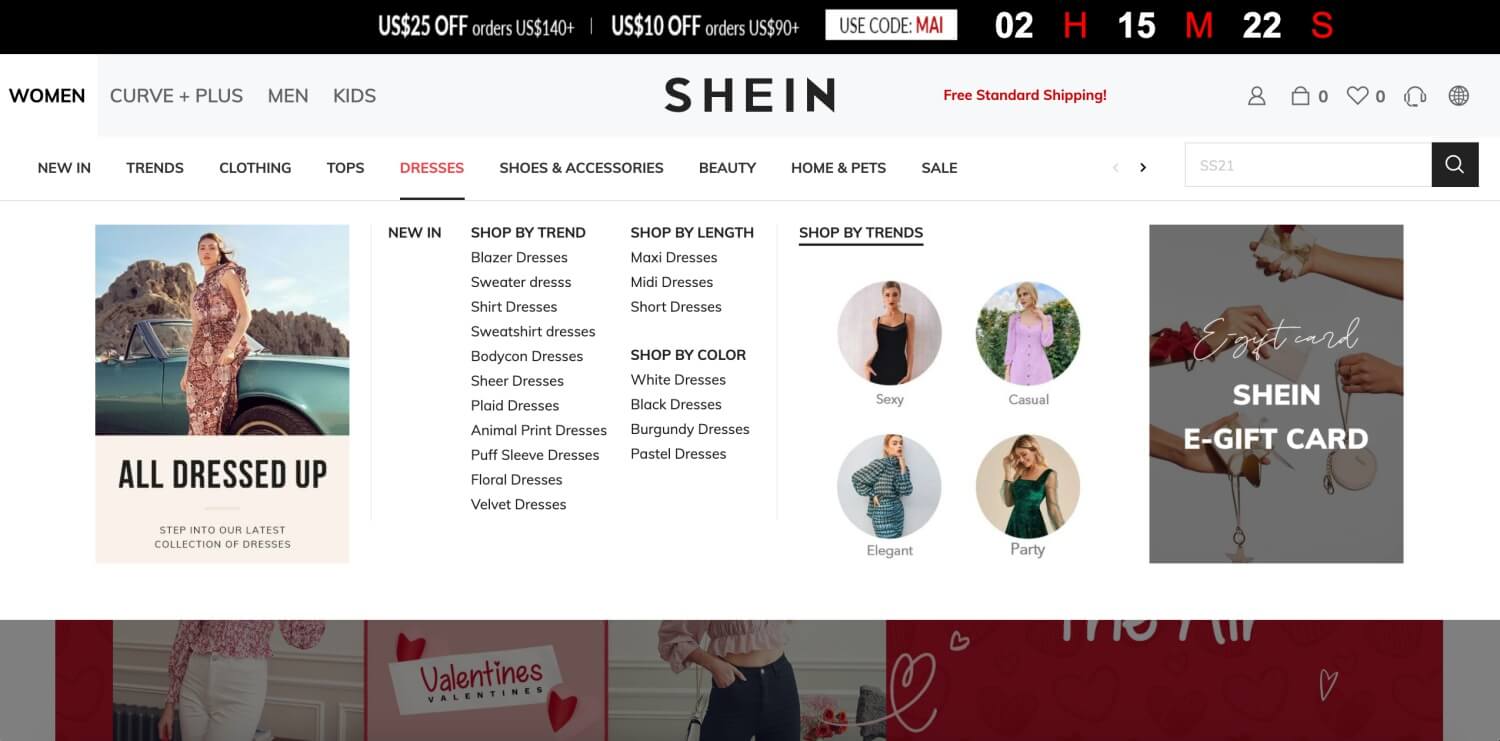
2. Homepage Merchandising
The homepage serves as the virtual window display in online retail.
Just as with brick-and-mortar stores, homepage merchandising needs to be inviting. But unlike physical retail, online, you have several ways to promote the right products on your digital storefront. The homepage acts as the central hub for your brand and products, and customers may often return to it for orientation.
Shane & Co. is a great example of an inviting homepage, optimized for discovery. The site:
- Invites shoppers to explore jewelry according to type, stone, price, and occasion.
- Educates shoppers with tips on buying jewelry, such as a budget calculator, matchmaker tool, and style quiz.
- Builds trust by offering virtual and in-store appointments and online chat, so shoppers can feel confident buying premium products.
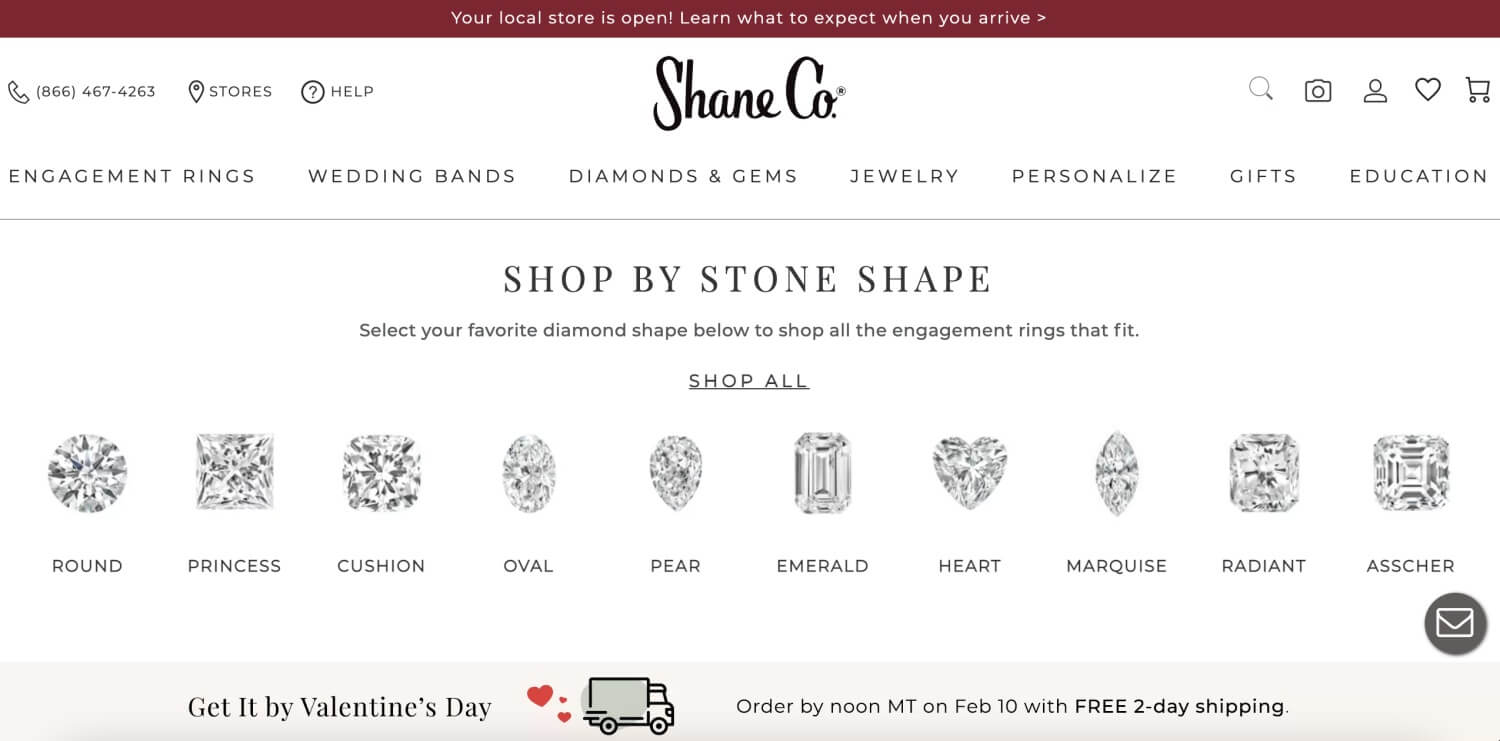
Retailers with thousands of SKUs can also incorporate advanced homepage merchandising strategies, such as dynamic collections and thematic galleries to boost product discovery.
- Dynamic collections: According to Salesforce and Publicis.Sapient, 69% of shoppers expect to see new products when they visit a site. You can retain your homepage’s freshness to keep shoppers excited with product groups or collections based on tags such as price, color, and more. Selecting which products to group together can be a strain on merchandising resources, especially when done daily. But some retail technology solutions enable you to do the bulk of the work automatically.
- Thematic galleries: For shoppers who have a vague idea of what they want, thematic galleries can provide inspiration and put your products in context. Just as typical store mannequins are dressed with new clothes to reflect the season, online thematic galleries can showcase items according to the occasion, such as “Sunday brunch” or personal styles, such as “Classic & Refined.”
For more tips on homepage merchandising, you can check out 10 brand examples here.
3. Category and Product Pages
Some 48% of consumers worldwide use search engines to find products. Because product search is very specific, most of these shoppers end up on your website’s category or product detail pages, rather than on your homepage.
Since these shoppers are typically deeper into their journey, it’s even more important that the merchandise you surface and promote aligns with their intent.
Category Pages
Mobly has an extensive inventory, but their product listing pages give shoppers a manageable way to move through the selection and find the most relevant products quickly:
- Shoppers can select items according to size and style, without having the specific measurements. Instead they can select “singles,” “couples,” and “children” to narrow down their search.
- New arrivals and popular products are highlighted to help direct shoppers quickly and efficiently to items they are likely to love.
- Discounts are clearly labeled.
- Shoppers can explore more product images on hover—no need to go to the detail page.
- Mobly also has a Pinterest-like visual search tool so shoppers can quickly find similar items to any item shown on the category page.
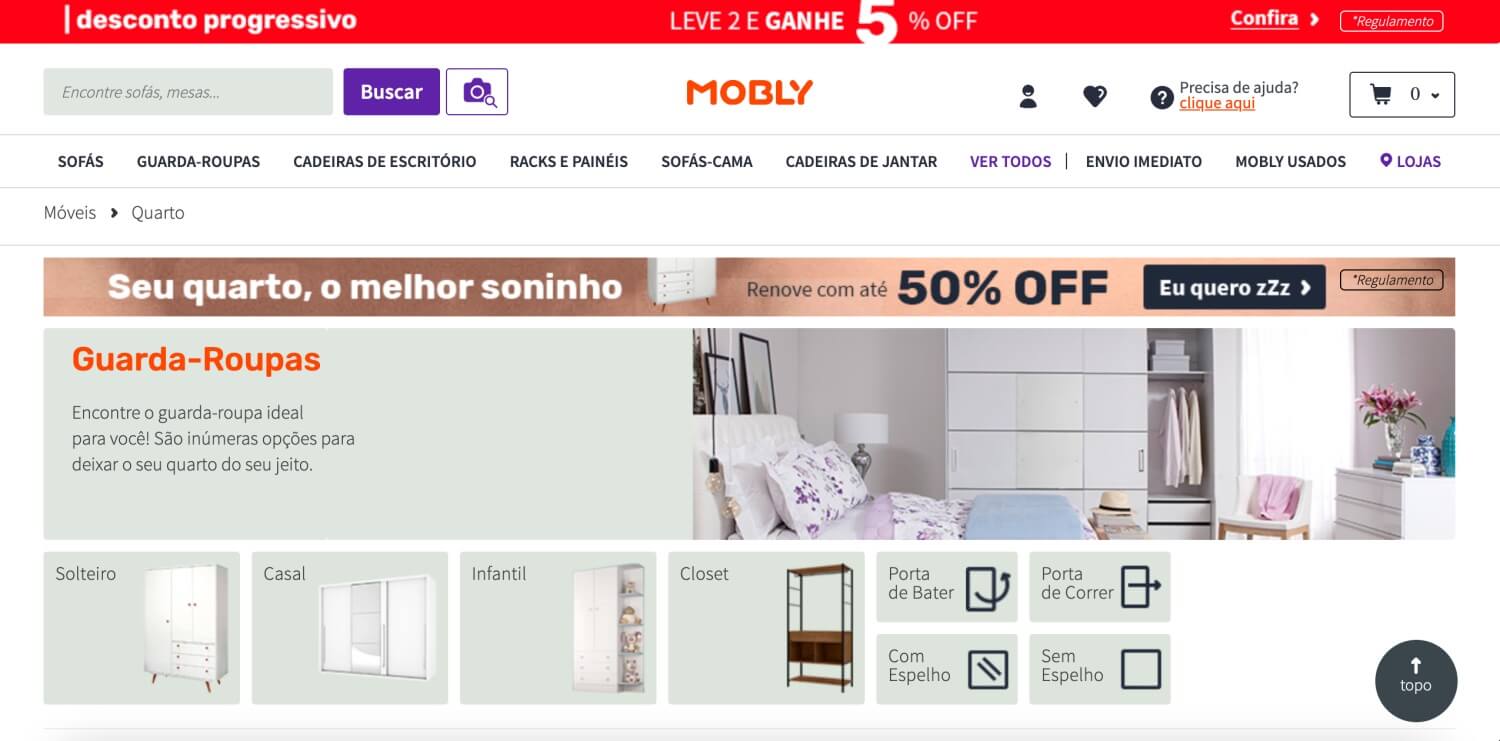
For more category and product listing page best practices, click here.
Product Detail Pages
By the time customers reach your PDPs, they need just the right amount of information to build trust in your products and lead them to conversion. Effective online merchandising will also make it easy and tempting for them to add additional items to their cart, or to find similar items when the size or color they’re looking for is out of stock.
- The details: Be sure to include high-quality photos, customer reviews, clear product descriptions, and payment, shipping, and returns information
- Product recommendations: Recommendation engines are a must-have when optimizing eCommerce merchandising for product discovery. On product detail pages, they help drive AOV and stop shoppers from dropping off if an item is not quite right. Mobly promotes visually similar items and complementary products on PDPs to ensure shoppers find the items they want to add to cart.
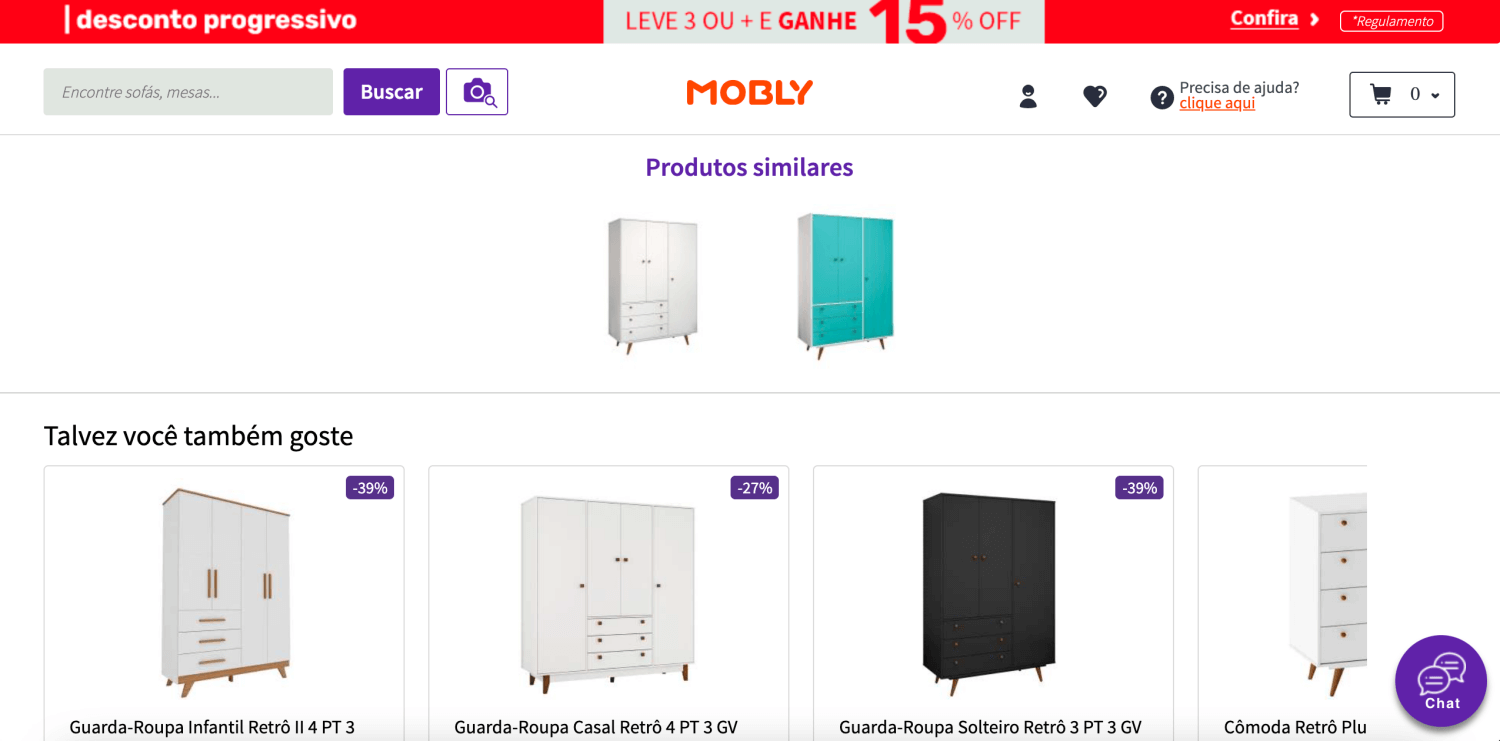
Learn more about boosting conversion and shopper engagement on product detail pages here.
4. Shopping Cart and Checkout
Think about the strategically placed products you see when you line up at the cashier in brick-and-mortar stores: Your eCommerce merchandising efforts shouldn’t stop when users add an item to cart. In fact, it creates another set of opportunities for promoting products.
French retailer La Redoute offers a continuous product discovery experience even at checkout, enticing shoppers not only to add more items but also to return in the future.
- Design-wise, the add-to-cart window is a pop-up, so it doesn’t interfere with the shopping journey.
- The popular “free shipping” and “add more items to get free shipping” notices encourage spontaneity.
- Product recommendations: To inspire customers to increase their basket size, La Redoute highlights items that “Other customers also bought” and “Last viewed products” on the shopping cart and checkout page.
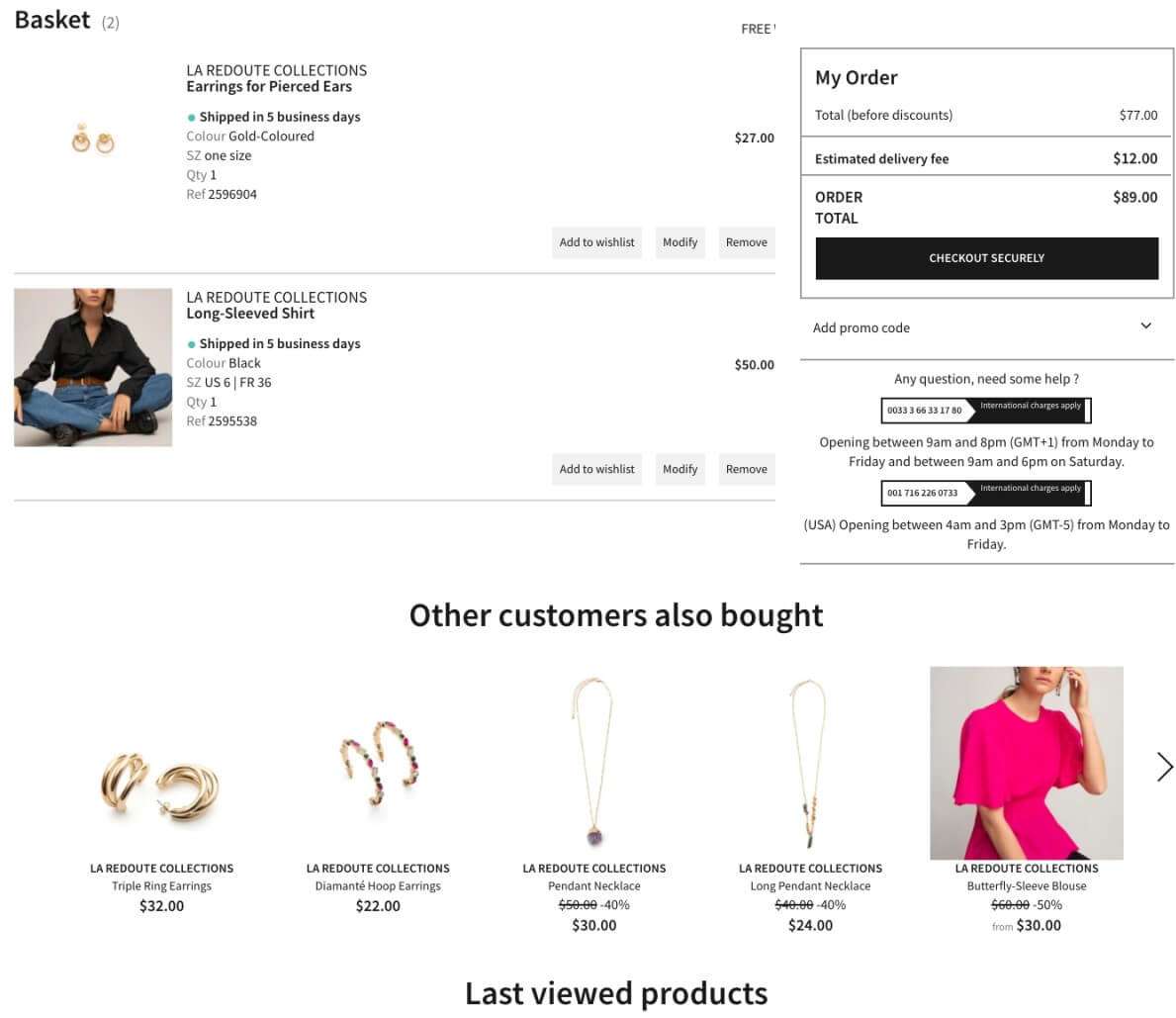
eCommerce Merchandising Best Practices: How to Level Up
Shoppers enter your website at different points, and it’s up to your eCommerce merchandising strategy to display the right products to the right people at the right time.
To further upgrade your online merchandising and product discovery strategy, the next step to take is personalization. However, the standard personalization seen on eCommerce sites today is essentially segmentation. In order to truly improve engagement and increase conversion, you will need to hyper-personalize merchandising and product discovery, based on the real-time interests, preferences, and actions of individual customers. With a robust product tagging system, you will be able not only to automate and experiment with product mixes and promotions but also to dig deeper into your shoppers’ browsing behaviors so you can ensure that your strategy resonates with each shopper on a personal level.
Since 80% of customers are more willing to purchase from a brand that delivers personalized experiences, brands and retailers aiming to consistently delight and retain shoppers must strive to achieve this kind of hyper-personalization from merchandising all the way through to marketing.